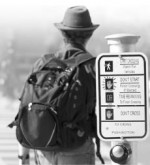Street smarts

With nearly 40,000 students sharing the roads and sidewalks at USF, traffic is always a cause for concern among pedestrians on campus.
In the past, Tampa has failed to measure up to pedestrian safety standards. The city was ranked second-worst in “Mean Streets 2004,” a report produced by the Surface Transportation Policy Project that analyzed the risk of pedestrian death in relation to the amount of foot traffic in several large metropolitan areas of the United States.
USF administrators feel the University is doing its best to implement safety measures in terms of new construction and upgrading traffic technology. Such technology – including a pedestrian countdown and a chime that signals when pedestrians may cross – is visible on the corner of USF Palm Drive and Fletcher Avenue, and near the Crescent Hill parking garage on Holly Drive, respectively.
“USF is doing different things to make (its campus) safer. Speed bumps force cars to slow down, and crosswalks with signs work. Some areas still don’t have pedestrian countdowns, but that’s more of a funding issue,” said Julie Bond, a senior research associate for the Center for Urban Transportation Research (CUTR). Bond is also on the Bicycle and Pedestrian Advisory Committee for Hillsborough County.
Fellow senior research associate Xuehao Chu said that measuring pedestrian safety is difficult because not all of the contributing factors can be monitored at all times.
“A city’s infrastructure is a possible factor in poor pedestrian safety, but we can’t be sure that it’s a main determinant,” he said.
A report released by the Florida Department of Transportation (FDOT), titled “Transportation Issues: Pedestrian Safety,” acknowledged the difficulties with adequately measuring pedestrian risk factors.
According to the report, “One (factor) is that Florida’s high fatality rate results from a combination of urban sprawl and low investment in safety capital. Associated with sprawl is a reliance on high-speed arterial highways – for example, U.S. Highway 19 in the Tampa Bay area. Along these highways, pedestrians are neither separated nor safeguarded adequately from vehicles traveling at high speeds, which could lead to a deadly situation.”
According to the “Mean Streets” report, 95 percent of pedestrians are likely to survive being struck by a vehicle traveling at 20 miles per hour, and only 15 percent are likely to live through a collision with a vehicle traveling at 40 mph.
“The competing view is that the conventional measures of fatality rates inadequately control for exposure – the amount of time people walk near traffic. For Florida, exposure is high relative to resident population because the state is visited by millions of tourists each year and because the warm, sunny climate encourages walking,” the FDOT report explained.
Florida’s climate also poses a greater risk for pedestrians who enjoy walking at night during the winter, as temperatures stay warm into the evening.
“Florida’s fatality rate during the night hours (6 p.m. to 6 a.m.) is more than double the (national average),” the report said.
“One of the issues I’ve seen around campus is that a lot of people don’t cross at the crosswalks, and they cross at night,” Bond said. Chu agreed that pedestrians’ behavior plays a significant role in potentially avoiding dangerous situations. Both researchers offered advice for students to become smarter pedestrians.
“Notice your surroundings, walk in the safest places, wear reflective clothing and never expect a car to stop for you,” Bond said.
While marked bike lanes have been recently added around off-campus housing, crossing several busy lanes of traffic can be a daunting task, even for frequent and experienced riders.
“It’s a little scary sometimes, but there’s enough room if drivers are paying attention,” said Cathy Day, a senior who regularly bikes to campus. “I’m not sure there’s much more USF can do, other than make sure that stopping at the crosswalks is more enforced. It’s easy to get hit when people are in a rush,” she said.
With gas prices continuing to soar, more local commuters may consider biking or walking to save a few bucks and get some exercise. To accommodate this demographic, Bond said cities must take a progressive approach to pedestrian safety.
“If we want to encourage pedestrian safety, we really have to make our cities walkable,” Bond said.
To rate how safe your local streets are, a walkability checklist can be found at walkableamerica.org/checklist-walkability.pdf.






